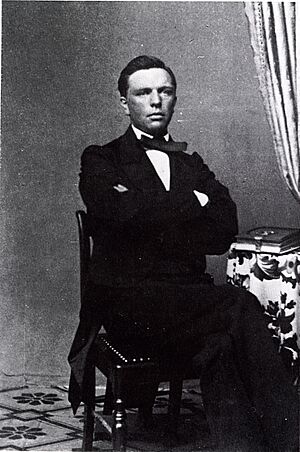Georg Andreas Bull facts for kids
Quick facts for kids
Georg Andreas Bull
|
|
|---|---|
 |
|
| Born | 26 March 1829 Bergen, Norway
|
| Died | 1 February 1917 (aged 87) |
| Occupation | Architect |
| Relatives | Ole Bull (brother) |
Georg Andreas Bull (born March 26, 1829 – died February 1, 1917) was a famous Norwegian architect. He worked as the main building inspector in Christiania (which is now Oslo) for 40 years! He was one of the most important architects in Norway. He also did cool things like studying old buildings and doing archaeological research.
Contents
Georg Andreas Bull's Early Life and Education
Georg Bull was born in Bergen, Norway. He was the youngest of 10 children in his family. His father was a pharmacist named Johan Storm Bull. His mother was Anna Dorothea Borse Geelmuyden. Georg had a famous brother, the violinist Ole Bull. His other brother, Knud Bull, was a painter.
Georg started learning to draw in Bergen. He had lessons from a German architect and painter, Franz Wilhelm Schiertz, from 1843 to 1845. After that, he studied machine engineering. He went to the Polytechnische Schule in Hannover, Germany, from 1846 to 1850. He even continued his studies in England.
Studying Old Buildings
After his engineering studies, Georg Bull became very interested in old buildings. He studied Haakon's Hall in Bergen. He also looked at other buildings from the Middle Ages. This included studying about twenty stave churches, which are unique old wooden churches. Later, he studied architecture at the Berliner Bauakademie from 1855 to 1856.
Georg Bull's Career as an Architect
Georg Bull began his work as an architect in Kristiania (Oslo) in 1857. One of his first big projects was the Christiania Dampkjøkken. After a large fire in Kristiania in 1858, he helped plan a new area. This area was called Homansbyen. He designed many of the buildings there between 1858 and 1866.
Designing Train Stations and More
Georg Bull was also the architect for the state railways (Statsbanene). He worked for them from 1863 to 1872. He designed many different types of buildings. These included churches, villas (large houses), train stations, and even storehouses.
He designed two important train stations in Oslo. These were Oslo Vestbanestasjon (Oslo West Station) and Østbanen (Oslo East Station). In total, he designed about sixty train stations across Norway! Some of these were for the Krøder Line, like the Krøderen Station (1872). He also designed stations for the Kongsvinger Line at Åbogen (1865), Matrand (1865), and Magnor (1865).
Buildings for His Brother Ole Bull
Georg Bull also designed buildings for his famous brother, Ole Bull. He designed a new farmhouse for Ole's summer home. This was at Valestrandfossen in Osterøy in 1865. He probably also designed Ole's unique oriental-style villa. This villa was on Lysøen in Os, near Bergen, around 1872.
Georg Bull was a member of several important groups. He was on the board of the Royal Danish Academy of Art. He was also on the board of the National Gallery. In 1874, he helped start the Norwegian Engineering and Architectural Association. He was honored for his work. He became a Knight, First Class of the Royal Norwegian Order of St. Olav in 1875. He was also a Knight of the Order of the Dannebrog.
Georg Bull's Family Life
Georg Bull was married to Emilie Constance Hjelm. They had nine children together. Their son, Henrik Bull, also became a well-known architect. Georg Bull passed away in 1917 in the Bestum area of Oslo.
Selected Architectural Works
Here are some of the buildings Georg Andreas Bull designed:
- Høle Church (Høle kyrkje) - 1858
- Vanylven Church (Vanylven kyrkje) - 1864
- Kragerø church (Kragerø kirke) - 1870
- Oslo West Station (Vestbanestasjonen) – 1872
- Koppang Station (Gamle Koppang stasjon) - 1875
- Oslo Central Station (Østbanestasjonen) - 1878
- St. James Church (Jakob kirke) - 1880
Images for kids




